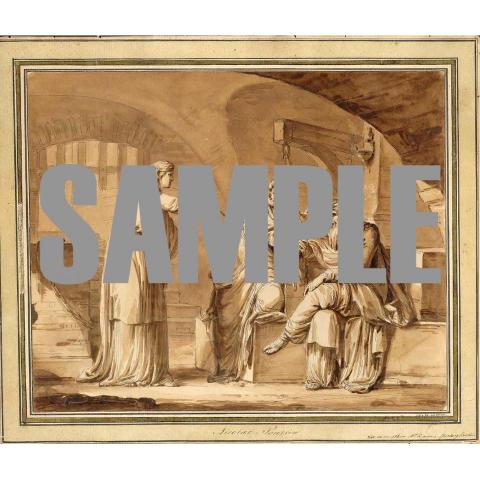Jean-Michel Moreau Joseph Interpreting the Prisoners’ Dreams circa 1780
- Ink, Paper, Watercolor
- Paper
- Pen
Jean-Michel Moreau, Le Jeune
(Paris, 1741 – 1814)
Joseph Interpreting the Prisoners’ Dreams
Pen, ink and wash on paper
14 ¼ x 20 ¾ inches (36.2 x 52.7 cm)
Provenance:
Princely Collection Isenberg-Birstein, Germany (according to the inscription on the mount: “son altesse le prince Ysemburg-Birstein,” not in Lugt)
John Boyd Thacher (1847-1909), New York (according to an inscription on the mount, not in Lugt)
Private Collection, California
This impressive drawing is a new addition to the oeuvre of Jean-Michel Moreau, Le Jeune. The artist is primarily known for his activity as a draughtsman, and his compositions were immensely popular and successful, especially his illustrations for literary works and his drawings of fashionable society in the last years of the ancient régime. Another facet of his production focused on classical, literary, and biblical subjects, of which this large sheet is a fine example. It is characteristic of the artist’s interior settings and figural arrangements in such scenes (Fig. 1). The masterful handling of light and shadow, carefully modulated through the application or absence of the fine ink wash, also bespeaks the artist’s hand.
Moreau Le Jeune trained under the painter and engraver Louis-Joseph Le Lorrain, with whom he traveled to Russia, spending a year at the Academy of Fine Arts in Saint Petersburg. After returning to Paris in 1759, he abandoned painting and began producing drawings, especially for engravers. He held several highly prestigious positions within the arts, including Dessinateur des Menus Plaisirs du Roi (Designer to the King) in 1770 and Dessinateur et Graveur du Cabinet du Roi (Designer and Engraver to the King) in 1781, and was reappointed to the latter position after the French Revolution. He joined the Académie Royale in 1789. Moreau is also known for having been the grandfather of Horace Vernet.
Our drawing depicts the biblical episode of Joseph interpreting the dreams of prisoners (Genesis 40). The life of the Old Testament hero was a frequent source of inspiration for works of art in the 17th and 18th century. After being sold into slavery by his brothers, Joseph became a servant to Potiphar, the captain of Pharaoh’s guard in Egypt. Falsely accused of attempted rape by Potiphar’s wife, Joseph was imprisoned and later joined by the Pharaoah’s baker and butler, who had offended their master. Each was plagued by disturbing dreams, which Joseph interpreted for them: the butler would be restored to his position in three days, while the baker would be hanged—as eventually would transpire.
The setting of our drawing is clearly a subterranean prison, indicated by the low arched ceilings and the raised portcullis visible at the top of the stairs. The young Joseph stands prominently on the left side of the composition, pointing at the two figures, each of which reacts differently to his predictions. The seated figure with a turban is the butler, who appears relatively relaxed as he gently holds the end of a broken chain, presaging his release in three days. The figure to the left, partially kneeling, is startled by the bad news he receives; he grasps the arm of his companion, raising his left hand in alarm. Above his head looms a gibbet, foretelling his imminent death. We are grateful to Dr. Jennifer Montagu and Don Francesco Saracino for independently identifying the subject of this work.
Benjamin Peronnet has confirmed Moreau le Jeune’s authorship of the present drawing, which had previously been attributed to Nicolas Poussin, as evidenced by the large inscription on the mount. Our sheet was formerly in the princely collection of the Isenberg-Birstein family in Germany. At least one other drawing from that collection, attributed to Primaticcio, passed with ours into the hands of the collector, Mayor of Albany, and US Senator John Boyd Thacher (1847-1909). The inscriptions on both drawings are clearly in the same hand and the mounts of both drawings indicate a common, as yet unidentified, source which likely predates the Isenberg-Birstein collection.





